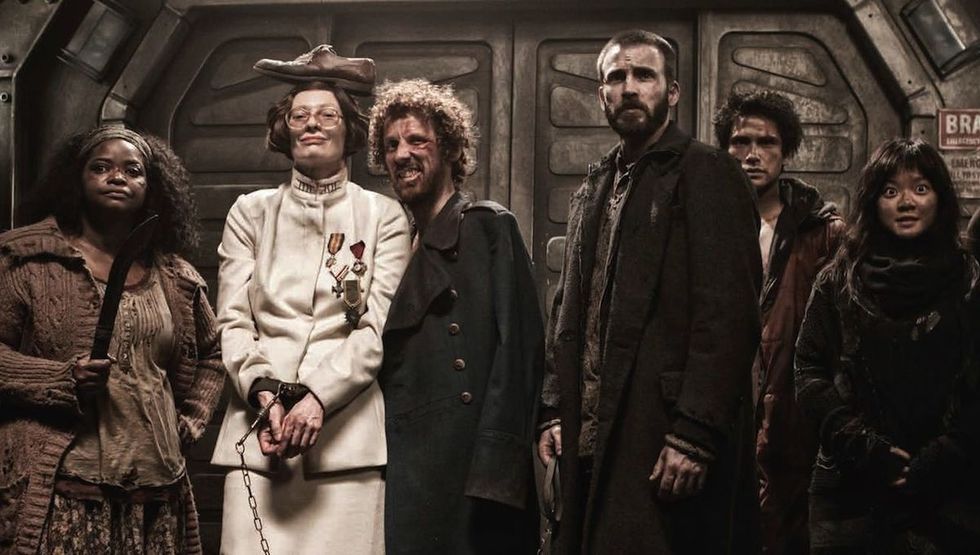
Chris Evans is no stranger to heightened storytelling and the unreal worlds that need to be created to sell the story to audiences. While the actor led the Marvel Cinematic Universe for almost a decade as Captain America, Evans revealed to GQ that working on Bong Joon-ho’s Snowpiercer was a starkly different and more tangible experience than working on any Marvel project.
Chris Evans Breaks Down His Most Iconic Characters | GQ
Although Evans had trouble “wrapping his head” around Joon-ho’s apocalyptic sci-fi film that saw Evans playing a lower-class citizen on an ever-moving train, the actor revealed that Boon-jo’s desire to have practicals on set made filming “incredibly helpful.”
“We had those cars on Gimbals, these little like… they just do like a subtle movement. So a lot of boat legs at the end of the day,” Evans said in his GQ interview. “You are kind of wobbly, getting back to your hotel room.”
He added, “[It was] incredibly helpful with the tangible environment as opposed to Marvel when you’re talking to green screens, imaginary aliens. Everything was right there and you could touch.”
Practicals were essential for Joon-ho to bring the actors into this heavy world-building world that was hard to picture on the page. However, actors need to trust that directors know exactly what they are doing before approaching them. A director has to get the actors to trust that they are in good hands.
“When you’re working with someone that knows exactly what they want, even if it’s not exactly the way you saw it, it breeds trust,” says Evans. “And as an actor, that’s the most important thing, to trust the director. Otherwise, you’re playing defense. Otherwise, you’re like, ‘Alright, this first take, well, I’ll just do this, just so I can at least protect that. Then I’ll try this, but I don’t want to try that because I don’t know if they know how to use that take. Any take I give them can be used against me.’ And when you have a director who is so convinced of what their vision is, that’s when you say, ‘Great. You say jump, I’ll say ‘How high?'”
The MCU has been infamous over the years for its increasing use of green screens and VFX shots. While it is understandable why green screens are used on these larger-than-life superhero movies, some actors have a hard time working within these unreal locations.
Some Marvel productions will shoot outside for different kinds of lighting and specific shots, but will still employ blue or green screens to put the actors in different worlds. This is cost-effective for the production, but actors are losing a sense of the location and how it plays into the story.
We are big fans of practical effects but also understand that practicals are not always… well, practical. However, it seems that a majority of the industry would love to work with practicals or include Unreal Engines on set to see what the world could look like in real-time.
Chris Evans’ Confusion Reading the Snowpiercer Script

While we might celebrate Snowpiercer as a fantastic sci-fi that wears its themes of classism on its sleeve, the script confused Evans at first due to its intense world-building
“When I first read the script, I didn’t quite get it. I was like, ‘So… what?’ Whenever it’s a movie that’s world-building, you’re creating a completely separate environment. There’s just kind of a conceit that you have to say, ‘OK, so everyone just accepts this, this is just how it is? No one is kind of outraged that this is the structure? That’s just the norm, OK.'”
Evans said that he was able to accept this reality by deciding what he was trying to pull from the screenplay. “You kind of have to decide what part of your brain do you spend time wrapping your head around,” Evans says. “Do you go the intimate road and just kind of make it about the character? Do you try and make it about what it took for that society to level into that place? It’s a challenge, but you get to watch Tilda Swinton in the movie and you get to watch her approach to this larger-than-life character.”
Boon-jo is a master storyteller, both on the page and behind the camera. It seems that he is great at communicating his vision with his cast and crew, and even better at translating that vision to the set with practicals.
Again, we love good practical effects here at No Film School and highly encourage you to use as many practicals as you can in any project. But our main takeaway from Evans’ experience on Snowpiercer is that a great director knows how to openly communicate and answer any questions that the cast and crew might have about any aspect of the screenplay. Always know what story you are trying to tell, and bring it to life without hesitation.
Source: GQ
Author: Alyssa Miller
This article comes from No Film School and can be read on the original site.
